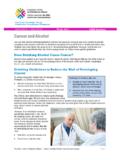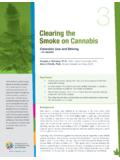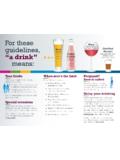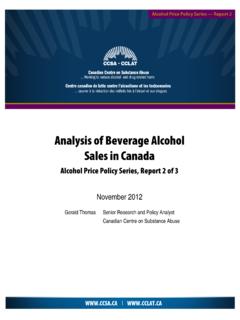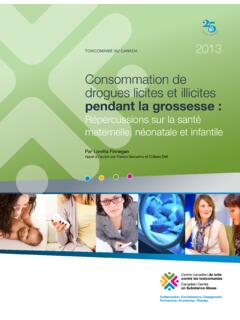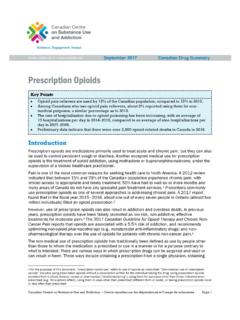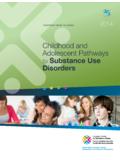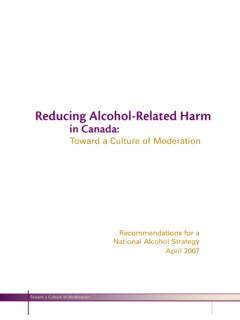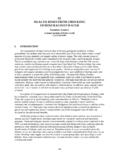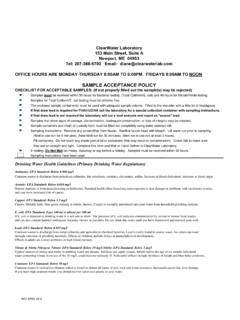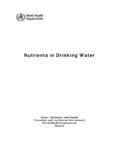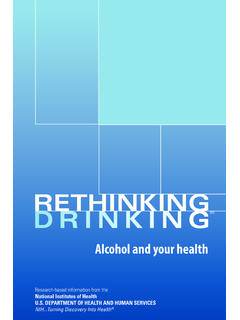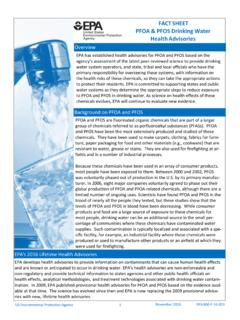Transcription of Alcohol and health in Canada: A summary of …
1 Alcohol and health in Canada: A summary of Evidence and Guidelines for Low-Risk drinking Authors Dr. Peter Butt College of Family Physicians of Canada Dr. Doug Beirness Canadian Centre on Substance Abuse Dr. Louis Gliksman Centre for Addiction and Mental health Dr. Catherine Paradis duc alcool Dr. Tim Stockwell Centre for Addictions Research of Disclaimer: The views expressed in this document are those of the authors and do not imply any broader agreement or approval by their employing or host institutions. Completed November 3, 2010 and published November 25, 2011 Alcohol and health in Canada: A summary of Evidence and Guidelines for Low-Risk drinking November 2010 Page 2 Alcohol and health in Canada: A summary of Evidence and Guidelines for Low-risk drinking Printed in Canada Canadian Centre on Substance Abuse 2011 This report may be freely reproduced and distributed.
2 Citation of the sources is required under copyright law. Suggested Citation: Butt, P., Beirness, D., Gliksman, L., Paradis, C., & Stockwell, T. (2011). Alcohol and health in Canada: A summary of evidence and guidelines for low risk drinking . Ottawa, ON: Canadian Centre on Substance Abuse. This report was commissioned by the National Alcohol Strategy Advisory Committee (of Canada). Ce document est galement disponible en fran ais sous le titre : L alcool et la sant au Canada: r sum des donn es probantes et directives de consommation faible risque ISBN 978-1-926705-79-8 Alcohol and health in Canada: A summary of Evidence and Guidelines for Low-Risk drinking November 2010 Page 3 Acknowledgements The authors are indebted to the following organizations and individual for the valuable feedback received in response to an earlier consultation draft of this document.
3 Alberta health and Wellness Brewers Association of Canada British Columbia Ministry of Healthy Living and Sport Canadian Association of Chiefs of Police Canadian Association of Liquor Jurisdictions Canadian Centre on Substance Abuse Canadian Vintners Association Centre for Addiction and Mental health Centre for Addictions Research of British Columbia Dr. Louise Nadeau duc'alcool health Canada MADD Canada National Native Addiction Partnership Foundation Nova Scotia Department of health Promotion and Protection Public health Agency of Canada Spirits Canada Association of Canadian Distillers The Student Life Education Company Yukon Liquor Corporation The authors also wish to thank the Canadian Centre on Substance Abuse (CCSA) for providing travel costs, expenses, a venue and a first-class secretariat to support our work. Carolyn Franklin hosted the meetings on behalf of CCSA and single-handedly coordinated, facilitated and provided a secretariat to enable the work to take place over a period of several months.
4 The authors owe her a huge debt of gratitude for making the process enjoyable, congenial and constructive. We thank our three expert peer reviewers, each drawn from different continents of the world and each sharing unique perspectives and special expertise in Alcohol epidemiology, prevention and policy. The Working Group also acknowledges with thanks the help of Matilda Stockwell in the preparation and presentation of some of the tables in the report. Alcohol and health in Canada: A summary of Evidence and Guidelines for Low-Risk drinking November 2010 Page 4 Alcohol and health in Canada: A summary of Evidence and Guidelines for Low-Risk drinking November 2010 Page 5 Alcohol and health in Canada: A summary of Evidence and Guidelines for Low-Risk drinking Executive summary This document is intended for health professionals, policymakers, communication experts and members of the public who may wish to be informed about low-risk use of Alcohol , whether for themselves or to advise others.
5 The summary of evidence provided here and the proposed Canadian Guidelines for Low-Risk drinking have both been developed by an independent expert working group with members drawn from Canadian addiction research agencies. The document has also been significantly strengthened by a process of international peer review conducted by three invited experts on Alcohol epidemiology and feedback from concerned individuals and organizations. These Guidelines have been developed against a backdrop of: a 14 percent increase in per capita Alcohol consumption in Canada since 1996; different advice provided by authorities in different Canadian provinces; a rapidly growing scientific literature that identifies both significant risks and some possible benefits from low levels of Alcohol consumption; and a national strategy document, Reducing Alcohol -related Harm in Canada: Towards a Culture of Moderation - Recommendations for a National Alcohol Strategy" (National Alcohol Strategy Working Group, 2007).
6 The Guidelines are intended to provide a basis upon which to advise all Canadians on how to minimize risks from their own and others' drinking in this complex environment. The Guidelines also acknowledge and support personal choices made by many Canadians to not drink Alcohol at all, whether for cultural, spiritual, health -related and/or other personal reasons. They are not intended to encourage individuals or communities who choose to abstain to take up drinking . High-risk groups and situations are also discussed in which either abstinence or extreme caution with Alcohol intake is advised, including Alcohol use during pregnancy, by youth, in association with high-risk activities (such as driving) and in combination with medication and/or other drugs. No separate guideline is provided for older Canadians, given that the major risk factors for this group (being physically unwell, using medication and reduced tolerance) are highlighted under Alcohol and health in Canada: A summary of Evidence and Guidelines for Low-Risk drinking November 2010 Page 6 other guidelines.
7 While the Guidelines are intended for all Canadians, we recommend the need for consultation with Aboriginal groups for a more nuanced community- and population-specific approach in order to more fully address their sometimes diverse and complex circumstances. The Guidelines identify three distinct types of risk from drinking : situations and individual circumstances that are particularly hazardous ( , women who are pregnant or planning to become pregnant, teenagers, persons on medication) and for which abstinence or only occasional light intake is advised; increased long-term risk of serious diseases caused by the consumption of Alcohol over a number of years ( , liver disease, some cancers); and increased short-term risk of injury or acute illness due to the overconsumption of Alcohol on a single occasion. There are different ways to establish recommended low-risk drinking guidelines for those who choose to drink.
8 A complication with assessing a low-risk level of Alcohol consumption for the long-term risk of serious diseases is that there is also evidence of health benefits in relation to diabetes and some cardiac diseases. The approach employed here was to identify a level of average daily consumption where overall net risk of premature death is the same as that of a lifetime abstainer because potential health risks and benefits from drinking exactly cancel each other out. While there are non-fatal health and social problems associated with drinking , the level of consumption for the risk of these has been less well quantified and so only studies on risk of death from all causes presently provide a means of balancing costs versus benefits for individual drinkers. Relative rather than absolute risks of adverse outcomes were assessed ( , the focus was on whether risk increased for individuals because of their drinking rather than whether they were already at high or low risk before drinking due to other characteristics).
9 In relation to short-term harms that can happen during or after a particular drinking occasion, an emphasis is placed on reducing risk by using good judgement about settings and associated activities that are consistent with low-risk drinking , as well as restricting the amount consumed per occasion. Alcohol and health in Canada: A summary of Evidence and Guidelines for Low-Risk drinking November 2010 Page 7 Average long-term consumption levels as low as one or two drinks per day have been causally linked with significant increases in the risk of at least eight types of cancer (mouth, pharynx, larynx, esophagus, liver, breast, colon and rectum) and numerous other serious medical conditions ( epilepsy, pancreatitis, low birthweight, hemorrhagic stroke, dysrythmias, liver cirrhosis and hypertension). Risk of these individual medical conditions increases with every increase in average daily Alcohol consumption over the long term.
10 In addition, there are a number of serious medical conditions caused entirely by hazardous Alcohol use, including Alcohol dependence syndrome, alcoholic psychosis, nervous system degeneration, alcoholic polyneuropathy, alcoholic myopathy, alcoholic cardiomyopathy, alcoholic gastritis, alcoholic liver diseases and hepatitis, Alcohol induced pancreatitis, fetal Alcohol syndrome, and Alcohol toxicity and poisoning. Low levels of consumption have also been associated with health benefits resulting in lower risks of illness and premature death, notably from ischemic heart disease, ischemic stroke and diabetes. Systematic reviews and meta-analyses that estimated risk of death from all causes were identified to help define a balance point of average daily consumption where the likelihood of harms and benefits exactly cancel each other out. A review by Di Castelnuovo et al (2006) indicated that maximum health benefits from drinking could be obtained with an average daily consumption of between a half and one standard drink per day.
